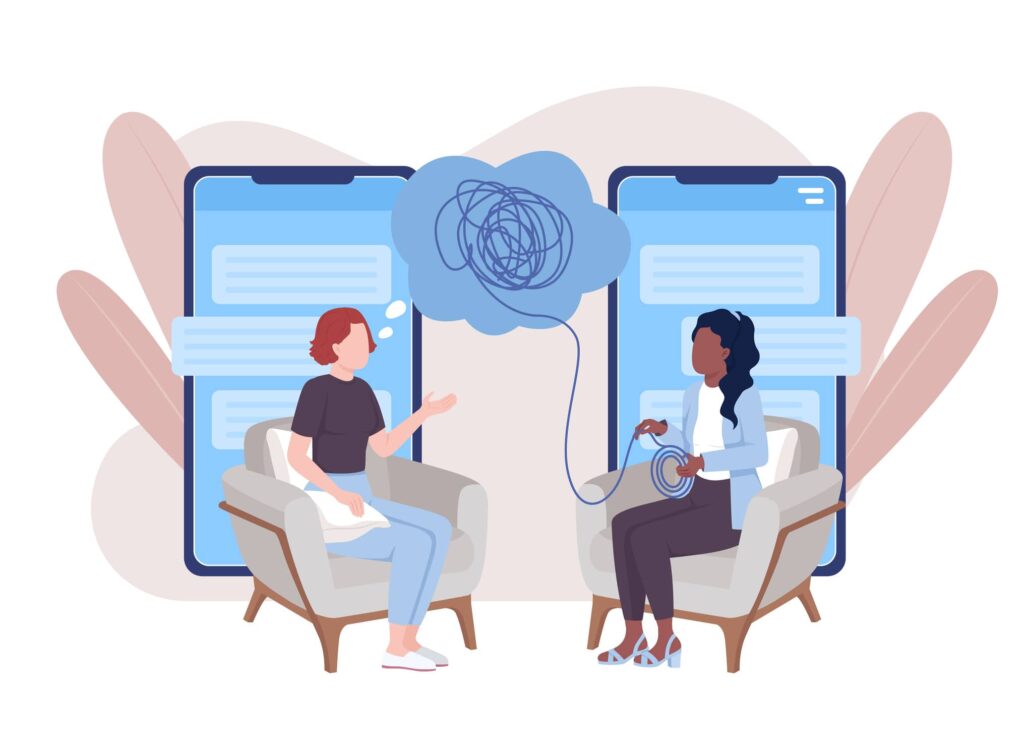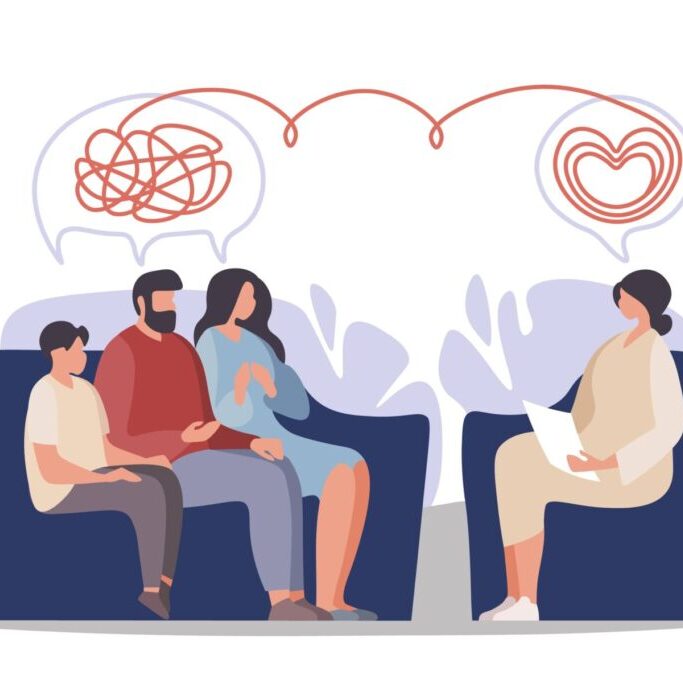Virtual vs. In-Person Therapy: Which One Really Works Best?

Deciding between virtual vs in-person therapy can feel like trying to choose between two great desserts. Both have their unique flavors, but the best choice depends on your personal tastes—or in this case, your lifestyle, needs, and mental health goals. As a therapist, I’ve seen firsthand the benefits of both, and I’m here to guide you through the decision-making process.
Understanding Therapy Formats
- What Is In-Person Therapy? In-person therapy, the more traditional option, involves meeting your therapist face-to-face in a private setting. There’s a sense of presence in these sessions that can create a “safe space” for sharing and exploring your emotions.
- What Is Virtual Therapy? Virtual therapy, also known as online counseling, connects you with a therapist using technology like video calls or phone sessions. The techniques used, the therapist’s obligation to confidentiality, and the foci of therapy are all the same!
But, is in-person vs virtual therapy more effective?
Is Virtual Therapy as Effective as In-Person Therapy?
So it’s convenient and flexible, and you can fit it between the other demands of your life. But, does virtual therapy work as well?
Believe it or not, virtual therapy has been around longer than you might think. Back in the 1950s, closed-circuit televisions were used to conduct psychiatric consults. Today, thanks to technological advances, we have more studies than ever demonstrating its effectiveness.
A meta-analysis is a statistical technique used to combine and analyze data from multiple studies on a specific topic to identify patterns, draw more robust conclusions, and enhance the reliability of findings. By synthesizing data across various studies, meta-analyses provide a higher level of evidence than individual studies, helping researchers understand the overall effectiveness or trends within a particular field. This type of study is the gold standard in determining if virtual vs in-person therapy is effective.
Meta-Analysis on Virtual Therapy Effectiveness
- Therapist-Guided Remote vs. In-Person Cognitive Behavioral Therapy – A systematic review and meta-analysis by Zandieh et al. (2024) evaluated the effectiveness of therapist-guided remote Cognitive Behavioral Therapy (CBT) compared to in-person CBT across various mental health and somatic disorders. The study concluded that there was little to no difference in effectiveness between the two modalities, suggesting that remote CBT is a viable alternative to traditional in-person therapy.
- Telehealth vs. Face-to-Face Therapy for Depression – A meta-analysis by Berryhill et al. (2019) focused on the efficacy of telehealth interventions compared to face-to-face therapy specifically for individuals with depression. The findings indicated that telehealth was equally effective as in-person therapy in reducing depressive symptoms, supporting the use of telehealth as an alternative treatment modality for depression.
- Virtual vs. Person Therapy using Cognitive Behavioral Therapy – An updated systematic review and meta-analysis by Carlbring et al. (2018) compared internet-based CBT to face-to-face CBT for various psychiatric and somatic disorders. The results demonstrated that virtual CBT was as effective as traditional in-person CBT, highlighting the potential of online interventions in delivering effective mental health treatment.
These meta-analyses collectively suggest that telehealth therapy, including virtual and telehealth-based interventions, can be as effective as in person therapy for various mental health conditions, offering a flexible and accessible alternative for individuals seeking care.
American Psychological Association’s Position on Virtual Therapy
The American Psychological Association (APA) recognizes the growing role of telehealth services, including virtual therapy, in providing accessible mental health care. According to the APA, an overwhelming number of psychologists (96%) believe that the use of telehealth during the pandemic has proven its worth as a therapeutic tool.
Patients also report high degrees of satisfaction with virtual mental health care and express interest in continued access to these services post-pandemic.
State of Illinois’s Position on Virtual Therapy and HB 3308
In July 2021, Illinois Governor J.B. Pritzker signed House Bill 3308 into law, expanding access to telehealth services across the state. The legislation requires insurance reimbursement parity for virtual mental health and substance use disorder services, ensuring that telehealth services are covered at the same rate as in-person services.
This law aims to solidify Illinois as a leader in telehealth access and expansion, making virtual therapy a permanent and accessible option for residents.
These developments reflect a significant shift toward embracing virtual therapy as an effective and accessible form of mental health treatment, supported by both research findings and legislative actions.
I’ve also seen this in my practice. One client, a young professional battling workplace anxiety, found virtual therapy a lifesaver. Being able to join sessions from her living room allowed her to stay consistent with therapy while juggling a demanding job.
But it’s not just convenience—it’s connection, too. Research shows that video therapy fosters a sense of closeness between therapist and client, almost as if you were sitting across from each other. This is crucial for building trust and creating an open dialogue.
The Benefits of Virtual Therapy
- Convenience and Accessibility – Virtual therapy removes logistical barriers. Forget traffic or babysitters—your session is just a click away. It’s especially helpful for clients in rural areas looking for a specialist (i.e., a queer affirming or LGBT therapist) or those with mobility issues.
- Cost-Effectiveness – Online therapy can be more budget-friendly. You save on transportation, childcare, and parking fees.
- Privacy and Confidentiality – Let’s face it: no one loves the idea of running into someone they know in a therapy waiting room. Virtual therapy eliminates that worry while maintaining strict confidentiality standards, just like in-person sessions.
Virtual therapy is an excellent option for busy professionals juggling packed schedules, parents who can’t step away from their kids, individuals with social anxiety who feel more comfortable at home, and those living in areas where access to quality therapists is limited.
The Benefits of In-Person Therapy
- Comprehensive Assessments – In-person therapy allows therapists to pick up on subtle cues—like shifts in posture or fleeting facial expressions—that might not be as noticeable online. These small details can offer big insights into a client’s emotional state.
- Specialized Modalities – Certain types of therapy, like Eye Movement Desensitization and Reprocessing (EMDR) or art therapy, require in-person interaction to be effective. These modalities rely on physical presence and sometimes specialized tools.
In-person therapy may be a better choice if you’re managing severe mental health conditions like schizophrenia, require a hands-on approach for treatments such as EMDR therapy, or find value in the ritual of visiting a dedicated therapy space.
Challenges of Virtual Therapy
Even with its many perks, virtual therapy isn’t perfect.
- Technology Issues: Poor internet connections or software glitches can disrupt sessions. I’ve had clients lose audio halfway through an emotional breakthrough—it’s frustrating for everyone involved!
- Limited Non-Verbal Communication: While video helps bridge the gap, it’s harder to pick up on subtle body language or shifts in energy through a screen.
- Not Ideal for Everyone: Clients experiencing psychosis, active suicidality, or severe mental health crises often need in-person care.
Challenges of In-Person Therapy
Traditional therapy has its downsides too.
- Accessibility: Clients in rural or suburban Chicago areas or those without reliable transportation may struggle to attend sessions regularly.
- Social Stigma: Walking into a therapy office can feel daunting for people worried about being judged.
- Inconvenience: Between commuting and waiting, in-person sessions can take a significant chunk of your day.
Finding the Right Fit
Ultimately, the “right” choice is the one that works best for you. Both virtual therapy and in-person therapy can help you achieve your mental health goals—it’s about finding the format that feels most supportive.
If you’re still unsure, why not explore both? At Tandem Psychology, we offer both virtual and in-person options tailored to your needs. Ready to take the next step? Reach out today, and let’s start your journey toward a healthier, happier you!
This blog is made for informational and educational purposes only. It is not medical advice. The information in this blog is not intended to (1) replace a one-on-one relationship with a qualified licensed health care provider, (2) create or establish a provider-patient relationship, or (3) create a duty for us to follow up with you.



